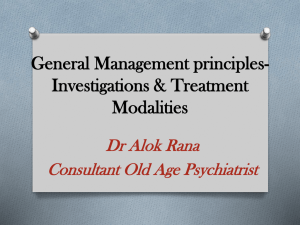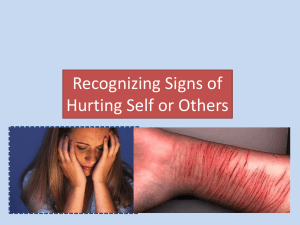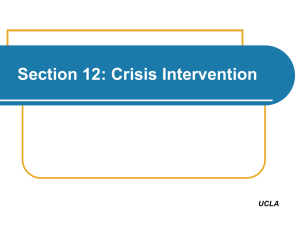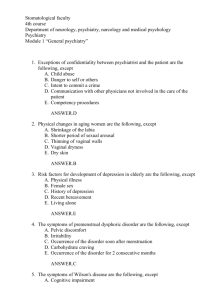Presentation on Mental Health Emergencies in Primary Care
advertisement
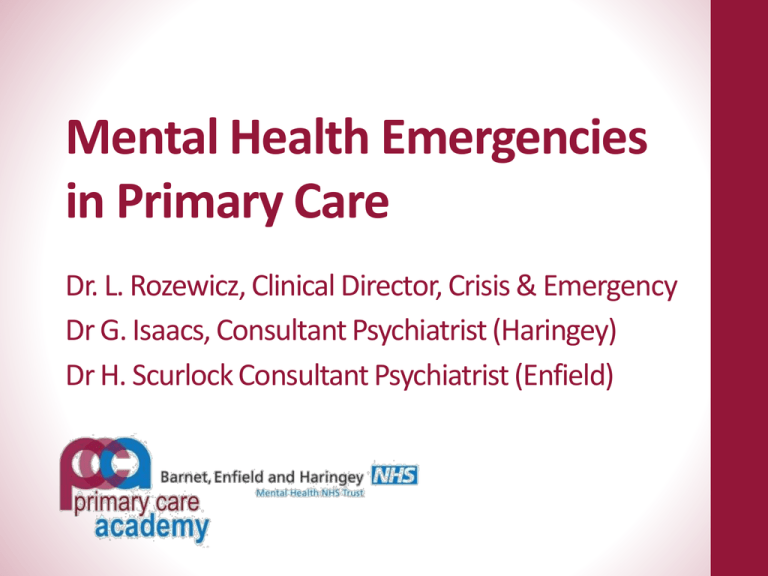
Mental Health Emergencies in Primary Care Dr. L. Rozewicz, Clinical Director, Crisis & Emergency Dr G. Isaacs, Consultant Psychiatrist (Haringey) Dr H. Scurlock Consultant Psychiatrist (Enfield) Overview Description of common problems What to do How to manage in primary care How to refer to specialist services Overview Emergencies relate to acutely disturbed behaviour They can occur in surgeries, patients homes or public places The most important initial decision is to exclude physical causes and or the effects of prescribed or not prescribed drugs Obtain a history from the patient and or carer or relative Acute confusional state Most often elderly and patients with dementia Fluctuating level of consciousness Visual and/or tactile hallucinations Disorientation in time/place Overaroused or underaroused Acute confusional state Physical oAcute infection (UTI, chest) oHypoglycaemia oHypoxia oHead injury – subdural oPost-ictal Acute confusional state Drug and Substance Misuse • Acute alcohol intoxication or withdrawal • Steroid psychosis • Amphetamine psychosis Acute mental health problems • Acute schizophrenia or psychotic depression • Hypomanic episodes of bipolar disorder • Personality disorder • Severe anxiety disorder, panic disorder Acute confusional state management Admit to a medical ward – not managed in psychiatric units Treat primary cause Manage the environment – avoid sensory deprivation e.g. windowless room, avoid sensory overload e.g. noise Think of patient safety, falls, infection, DVT, constipation Major tranquillisers at low doses Behavioural and Psychological Symptoms in Dementia BPSD – non cognitive symptoms in dementia (psychosis, agitation, mood disorder) FGAs traditionally used – haloperidol SGAs better as no EPS Risperidone licensed in UK for up to six weeks SGAs now controversial (small effect size, sedation, increase in CVAs and all cause mortality, cognitive decline) Behavioural and Psychological Symptoms in Dementia Use risperidone (0.5-1mg), refer within seven days to specialist Olanzapine is second line (5mg) Stop after 2-3 weeks unless there is a specific indication Acute mental health problems – general approach Acute Anxiety Agitated Depression Impulsive violence secondary to poor anger control Acute psychosis Acute mental health problems – general approach If violence is involved (or if there is a history of violence ask for police support) Gather information from records, family, carers – think about drugs and alcohol Tell receptionist your are visiting, call back within fixed time to confirm that you are OK, get receptionist to call police if they do not hear from you Visit with someone else if possible Do not try to restrain patient Have an exit route Anxiety Disorders Very common chronic disorders in 10% of patients Common overlap with depression Commonly present with physical symptoms CBT 7-14 hrs from IAPT (CBT is better than medication) Avoid Benzos Use SSRIs (Sertraline 50mg and then increase) or Pregabalin (75mg bd) Pregabalin ‐ binds to α2δ subunit of the voltage dependent calcium channel ‐ works as quickly as benzos ‐ 75bd to 300bd (increase gradually) ICD-10 Criteria for Alcohol Dependence A strong desire or a sense of compulsion to drink alcohol Difficulty in controlling drinking in terms of its onset, termination or level of use A physiological withdrawal state Evidence of tolerance Progressive neglect of alternative pleasures Persisting with alcohol use despite awareness of harmful consequences AUDIT Alcohol Use Disorders Identification Test 10 Questions Takes 5 minutes 92% sensitivity with 8 cut off 95% specifity Treatment Options - Alcohol Refer to local alcohol service GP detox (chlordiazepoxide) Consider acamprosate post detox DTs – refer to medics Dependence and active suicidal refer to HTT Suicide Typical GP will see one suicide every five years on their list One a year in a 10 000 group practice 8.5/100000 per year No single assessment tool Risk Factors for Suicide: Socio-Demographic Females more likely to attempt than males Males more likely to die Young and Old Poverty, unemployment Prisoners Risk Factors for Suicide: Family and Childhood Parental depression, substance misuse, suicide Parental divorce Bullying Risk Factors for Suicide: Mental Health Problems Impulsive, aggressive or socially withdrawn Poor problems solving ability Mood disorders; bipolar, psychotic depression Substance/alcohol misuse Schizophrenia Recent discharge from psychiatric hospital Risk Factors for Suicide: Suicidal Behaviour Access to means (guns, drugs, tablets) History of suicide attempts Specific plans Suicide Questions How does the future look to you? What are your hopes? Do you wish you could jut not wake up in the morning? Have you considered doing anything to harm yourself, or to take your own life? Have you made actual plans to kill yourself? What are they? What has stopped you from doing anything so far? Care Plan Document problem and provisional diagnosis in the notes Document risk assessment Management plan Record discussion with patient about problem/management plan Record patient views


